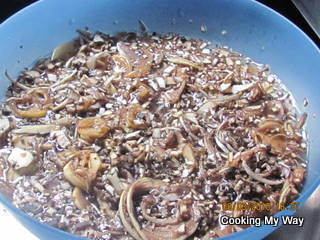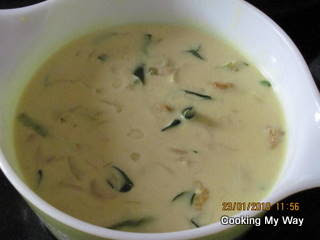An essential ingredient in Assamese cuisine is khar. The literal meaning of khar is 'of alkaline nature' but this bit of information is for non Assamese readers only. I wouldn’t dream of referring to Chicken Adhkhoria as Chicken Alkali!!
Basically, khar is an indigenous preparation and gives a different dimension to foods flavoured with it.
It is prepared from a particular variety of the banana tree called Athiya. There is an innumerable variety of preparations using this special ingredient, identifiable if the recipe has a suffix of khar to it. Indigenous khar, however, may be substituted with baking soda.
The recipe below may be substituted with fish, lamb or any game bird available. A popular recipe is Paror Adhkhoria or Pigeon Adhkhoria.
The word Adhkhoria can be broken up into two parts. Adh or Adha (half) and Khoria or pertaining to khar. It just means that one uses half the quantity of khar that is normally used in any other khar preparation.
Adhkhoria is always made along with vegetables like raw papaya, squash, gourd or greens, which don’t retain their shape but form part of the gravy. The heat in the dish comes from black pepper.
I have chosen to make my Chicken Adhkhoria with locally available greens.
Chicken (bone in) 600 gms
Ginger paste 1 Tbls
Garlic paste 1 Tbls
Turmeric powder ¾ tsp
Salt 1 tsp
Cumin powder ¾ Tbls
Black pepper powder 1 to 1 ½ Tbls (I like mine spicy)
Water to prepare spice paste
Greens 2 bunches, picked and washed until completely free from grit. Blanch until just wilted. Drain.
Mustard oil 2 ½ Tbls
Onions, chopped ½ cup
Baking soda (khar) ¼ tsp
If you had to use the indigenous khar which is liquid, you might have to use a couple of Tbls depending on the strength of the decoction.
Green chillies 2 to 3 (whole for flavour)
Hot water
Coriander leaves ¼ cup, chopped
Method
Clean, wash and dry the chicken. Cut into bite sized pieces. Blend together the next four ingredients and marinate the chicken in this paste for 3-4 hours or overnight in the fridge. Make a paste out of the cumin and pepper powders using a little water and set aside.
Chop the blanched greens. You can puree the greens in a blender if you wish. It is a personal choice.
Heat the mustard oil to smoking point. Cool a bit and throw in the chopped onions. Sauté until translucent.
Add the cumin paste and keep stirring on medium heat until the spice paste is wonderfully aromatic and releases some of its oil. Now add the marinating chicken and blend well to coat each succulent morsel with the spice paste.
A sprinkling of hot water may be required at anytime during the cooking process in order to release the toasted spice paste that sticks to the bottom of the pan during the frying process ( bhunao)
Blend in the chopped greens, the green chillies and the khar and cook covered stirring occasionally until the chicken is cooked and the greens form part of the gravy. This might take about 45 mins.
Add the chopped coriander leaves.
Serve hot with plain white rice. You can even have it with rotis (Indian bread).











